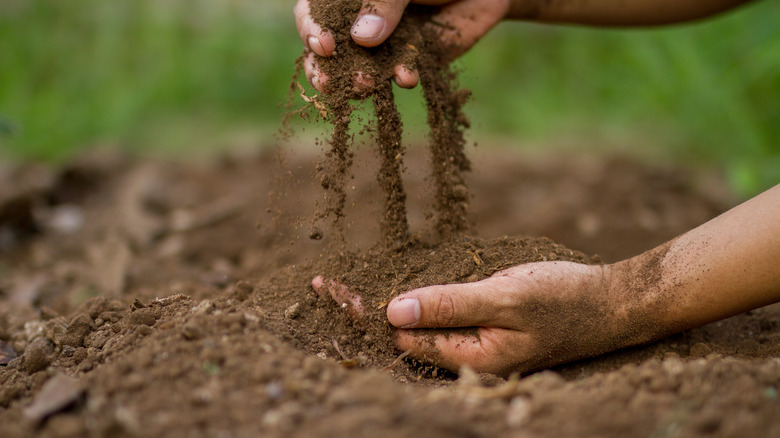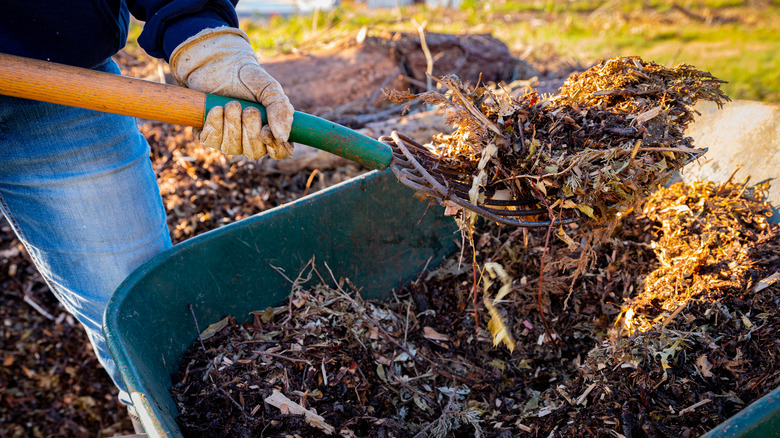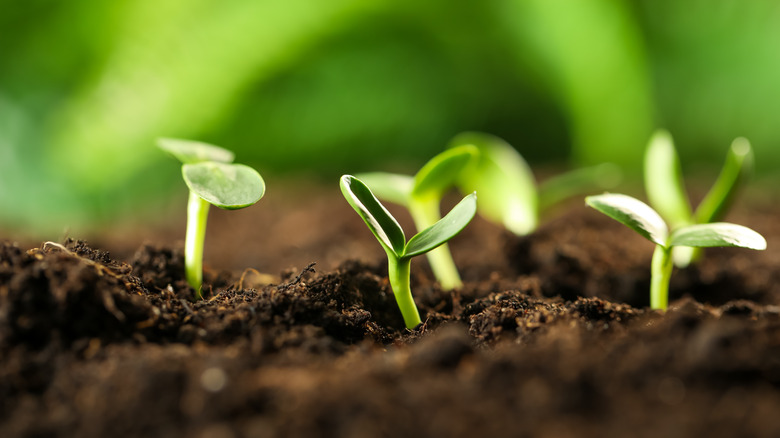What Are Soil Conditioners And Do I Need To Use Them In My Garden?
All home gardeners wish our backyard plots were naturally graced with the fertile, humus, compost, and nutrient-dense soil we see pouring out of our bags of potting mix from the garden center, yet how many of us actually have that? Very few, if any. Once we start digging into the earth, many of us find poor-quality soil that doesn't look or feel anything like what we purchase at the store.
This low-quality suburban backyard soil is often deficient in the life-sustaining nutrients that encourage roots to grow. It might look all right when you water it, but ultimately there's not enough organic matter to properly feed and nurture growing plants. Then there are the poor souls stuck trying their hand at gardening in compacted or clay soil. They can tell you it's a trying affair at best. This kind of soil is dense and basically turns to mud when it rains, making it difficult for proper drainage to occur. Alternately, some of us are dealing with extremely dry, brittle soil that seems more like playground sand than anything else.
University of Maryland Extension says a lack of healthy topsoil is a major problem. Sometimes topsoil is removed during a construction project and replaced by low-quality dirt. Other times, it gets washed away by stormwater runoff during an intense weather event.
If you're dealing with poor-quality soil, help is on the way! It's time to learn about the art of soil conditioning.
What are soil conditioners
Just because you start out with poor-quality soil doesn't mean you're stuck with it. Soil conditioners, also called amendments, represent your most effective line of defense against deficient soil. Common types of soil conditioners include leaf mulch and yard trimmings, DIY compost, pine bark, and substrates such as perlite and vermiculite.
Per gardening expert Ron Finley's MasterClass, rather than bagging up all those leaves you rake in the fall, you can store them in a pile throughout winter. They will begin to decompose and can be mixed directly into your garden soil come springtime. Nutrient-rich compost, along with the decomposing organic leaf matter, will add even more nutrients. This organic matter also feeds the worms who are hard at work underground, turning your useless dirt into a fertile oasis. They deserve a feast!
For thick clay soil, pine bark is one of the best amendments for improving soil structure. Large chunks of bark break up the dense clay and allow oxygen to flow through to plant roots; this is called aeration. This extra space also gives excess water a path to flow away from the roots so that it doesn't collect and become stagnant, which can lead to root rot; this is what is referred to as proper drainage.
Soil conditioners really do have the potential to reverse all of the problems that come from deficient soil. Aim for a ratio of one part conditioners and amendments to three parts soil.
Best practices with soil conditioners
LSU AgCenter suggests performing a soil test in the fall. The results will provide you with information and recommendations regarding which conditioners you should apply. It will also help you avoid common mistakes when fertilizing your garden by telling you exactly which nutrients are out of balance and how to fix it. If a soil test is not an option, you can rely on your instincts by picking up a handful of soil and running it through your fingers. A gritty texture alerts you to high levels of sand. Silt is finer and feels similar to baking flour. Clay can be rolled into a hard, sticky ball. The holy grail of loam is a balanced mix of everything. It will feel crumbly and be easy to work with.
Understanding your soil in the fall puts you ahead of the game. For instance, if your soil pH comes back low, you might want to apply lime a few months in advance of planting. Almanac says that adding organic matter in the fall is a good practice too because it gives worms plenty of time to work their composting magic.
As winter winds down and the promise of spring is on the horizon, it's time to concentrate on preparation; tilling and working in conditioners before you begin planting is the best path to success. OSU Extension Service reminds us that soil conditioning is not a one-and-done application. It's an improvement process we continue over time.


